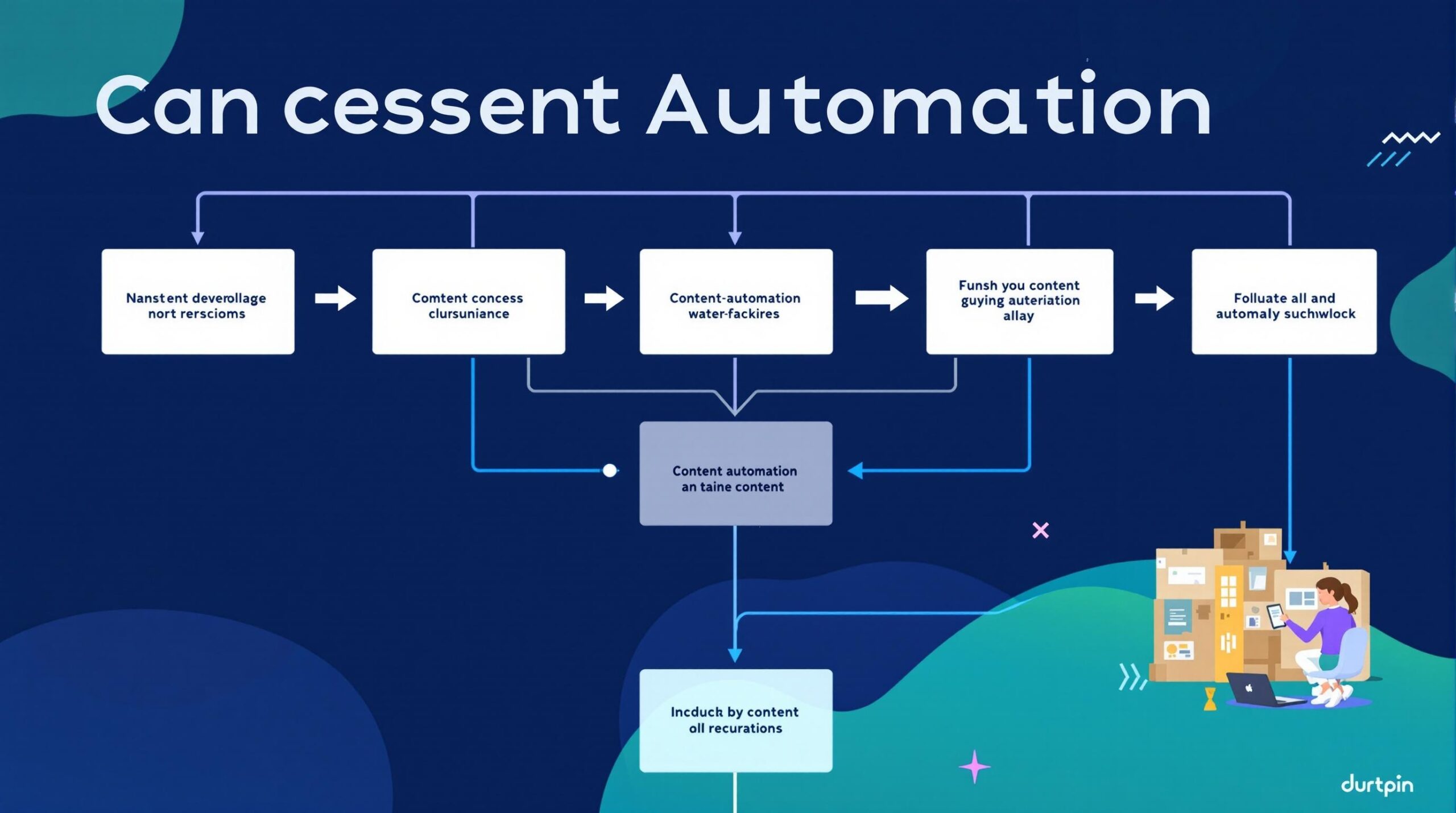How to Set Up Automated Content Workflows for Your Blog
Automated content workflows have revolutionized the way bloggers manage their publishing process, combining AI tools with human oversight to dramatically increase efficiency. These integrated systems connect everything from keyword research and content creation to SEO optimization and publishing, allowing bloggers to scale their production while maintaining quality standards.
Key Takeaways
- Implementing automated content workflows can reduce manual effort by up to 80% while maintaining quality
- Using AI writing tools like BrandWell and Jasper combined with strategic human editing creates the optimal balance
- Standardized templates reduce editing time by 30-50% and ensure consistent brand voice
- Proper automation can help blogs scale from 30 to 300 posts monthly while maintaining readability
- Starting with a simple 2-3 tool workflow provides immediate time savings without overwhelming your process
The Power of Content Automation: Streamlining Your Blog Operations
Content automation has transformed blogging from a time-intensive process to a streamlined production system. By connecting various tools through automated content workflows, bloggers can reduce the manual work involved in publishing by up to 80%. This efficiency gain doesn’t necessarily come at the expense of quality—when implemented correctly, automation enhances consistency while freeing up time for strategic thinking.
The most effective automation systems integrate tools across the entire content lifecycle: ideation tools that generate topic ideas, AI writing platforms that create drafts, SEO optimization tools that ensure content ranks well, and publishing systems that distribute finished pieces. Each step maintains checkpoints for human oversight, ensuring the final product aligns with your brand’s voice and quality standards.
A properly designed workflow acts as your content production blueprint, creating a repeatable process that scales as your blog grows. This structured approach eliminates bottlenecks and reduces the cognitive load on your team, allowing them to focus on adding unique insights rather than repetitive tasks.

Selecting the Right Automation Tools for Your Blog
Choosing appropriate tools forms the foundation of your automated workflow. The best approach is selecting tools that align with your specific needs rather than adopting every available option. Here are the essential categories to consider:
AI Writing Tools form the core of content automation. BrandWell stands out by generating comprehensive 3,000-word drafts in under 10 minutes, complete with built-in plagiarism checks and SEO optimization. Jasper excels at creating shorter-form content with a conversational tone. The key is finding a tool that matches your content style and length requirements.
For connecting various platforms, workflow automation tools like Make.com create seamless integrations. These tools can trigger a series of actions—for example, automatically sending an AI-generated draft to an editor via Slack when a new keyword is added to your content calendar in Airtable.
SEO tools such as Clearscope ensure your content meets search engine requirements. They analyze top-performing content for your target keywords and provide recommendations to improve your draft’s ranking potential. Content automation tools with built-in SEO can save significant time compared to manual optimization.
For enterprises needing high volume, Content at Scale combines bulk generation capabilities with quality controls, while Curata adds automated content curation to keep your blog updated with industry news. The right tool combination depends on your publishing frequency, content types, and available human resources for oversight.
Creating Standardized Templates for Consistent Output
Templates serve as the backbone of efficient content automation, reducing editing time by 30-50% through standardized structure and tone. Well-designed templates guide AI tools to generate drafts that closely match your brand voice and content requirements from the start.
Make.com users typically define these templates in platforms like Notion or Airtable, specifying sections such as:
- Introduction structure with hook requirements
- Key section headings and content expectations
- Call-to-action formatting and placement
- Image placement instructions
- SEO elements like heading hierarchy and keyword density
Tools like Jetpack AI Assistant take templates further by incorporating complete style guides into the content generation process. This ensures all automated content adheres to editorial standards regarding voice, prohibited phrases, and formatting conventions.
According to a Semrush study, teams with documented content workflows improve productivity by 45% compared to those working without standardized processes. This productivity boost comes from reduced revision cycles and clearer expectations at each production stage.
For multi-format blogs, creating separate templates for different content types is essential. Narrato users develop distinct formats for how-to guides, listicles, case studies, and news updates, each optimized for its specific purpose and reader expectations.
Building Your Automated Content Pipeline
An effective content pipeline connects multiple tools to create a seamless production flow from idea to published post. The key is strategic integration that maximizes each tool’s strengths while maintaining quality checkpoints.
Start by integrating AI writing tools with specific prompts for different content sections. For example, BrandWell might generate comprehensive article outlines while Jasper creates product descriptions within those articles. Content at Scale can then repurpose existing articles into new formats, extending the value of your content investment.
Automated SEO optimization should be built into your workflow, not added as an afterthought. Tools like Clearscope and Semrush analyze top-performing articles to recommend primary and secondary keywords, which can be automatically incorporated into your drafts. Testing shows that AI-optimized content achieves 15-20% higher organic traffic compared to manually optimized posts.
CMS integrations eliminate the manual uploading process. WordPress and Shopify users can set up automated publishing via Make.com, which schedules posts based on editorial calendars stored in project management tools. Automating your blog content creation includes these publishing steps to complete the workflow.
Distribution automation ensures your content reaches audiences across channels. Buffer and Hootsuite can synchronize with your CMS to automatically share new posts on social media platforms, boosting content reach by approximately 40% compared to manual sharing.
Maintaining Quality with Human Oversight
While automation dramatically increases efficiency, human oversight remains essential for maintaining quality and authenticity. The most successful blogs implement a hybrid approach that combines AI efficiency with human creativity and judgment.
Editors should use quality assurance tools to verify AI-generated content. Grammarly checks for writing clarity and correctness, while Originality.ai verifies the text is unique and not plagiarized. These tools help reduce factual inaccuracies by up to 90% compared to unchecked AI writing.
Strategic workflow design includes quality checkpoints where human editors add value:
- Adding personal anecdotes or brand-specific insights
- Incorporating EEAT (Experience, Expertise, Authoritativeness, Trustworthiness) elements
- Refining technical explanations for accuracy
- Adjusting tone to match brand voice more precisely
- Adding timely cultural references or industry context
Make.com workflows can route drafts to appropriate editors via Slack notifications, setting a 24-hour turnaround expectation to maintain production pace. Automating blog posts without sacrificing quality depends on this human touch at strategic points.
The data supports this hybrid approach: human-edited blogs typically achieve 25% higher engagement rates than fully automated posts, while still cutting production costs by approximately 60% compared to completely manual processes.
Scaling Production for High-Volume Publishing
Once you’ve established reliable automated workflows, scaling content production becomes considerably easier. Advanced users often batch-process content, generating 10-20 article outlines simultaneously through Make.com integrations with OpenAI.
Content repurposing amplifies your production capacity. Content at Scale can transform webinar transcripts, whitepapers, and case studies into multiple blog posts, increasing lead generation by approximately 35%. This approach maximizes your return on existing content investments.
For news-focused blogs, curation tools like Curata automatically collect and publish industry updates with minimal human intervention. This keeps your blog fresh with timely content even when your team is focused on creating original pieces.
Multilingual blogs can scale globally using Narrato’s automated translation and localization features. The system uses AI to adapt content for different markets and can schedule posts to appear at optimal times for each region’s audience.
The most sophisticated workflows enable planning months in advance, with content automatically moving through creation, editing, and scheduling stages based on predefined timelines. This forward planning creates predictable content pipelines that support marketing initiatives and seasonal strategies.
Case Study: From 30 to 300 Posts Per Month
A specialized industry blog achieved remarkable growth by implementing a comprehensive automated content workflow. Using BrandWell for draft generation and Make.com for workflow integration, they increased their publishing frequency from 30 to 300 posts monthly while maintaining a 4.2/5 readability score.
Their five-step workflow operated as follows:
- Perplexity.ai automatically identified trending industry keywords daily
- BrandWell generated comprehensive article drafts based on these keywords
- Subject matter experts added EEAT insights and industry context
- Clearscope optimized each piece for search visibility
- Make.com handled publishing to WordPress and social distribution
The results were impressive: traffic grew from 10,000 to 250,000 monthly visitors within six months of implementation. Equally important, they achieved a 50% reduction in operational costs through automation while maintaining content quality standards.
This case illustrates the potential of well-designed automated workflows—combining AI efficiency with strategic human input creates a scalable system that delivers both quantity and quality.
Getting Started: Your First Automated Workflow
Beginning with automation doesn’t require implementing a complex system immediately. Start with a simple workflow connecting 2-3 tools that address your current pain points. For example, connect keyword research to content drafting to publishing.
Make.com or Zapier provides an accessible entry point for connecting existing blog tools without coding knowledge. These platforms offer pre-built templates for common content workflows that you can adapt to your specific needs.
Always implement a quality assurance checkpoint with human review before publishing, especially when you’re new to automation. This ensures your content maintains your brand standards while you refine the process.
Consider these practical first steps:
- A/B test performance between automated and manually created content
- Create templates for your most common blog post types
- Automate the drafting process but retain human editing
- Set up automated distribution to social channels
- Implement SEO checks before publishing








